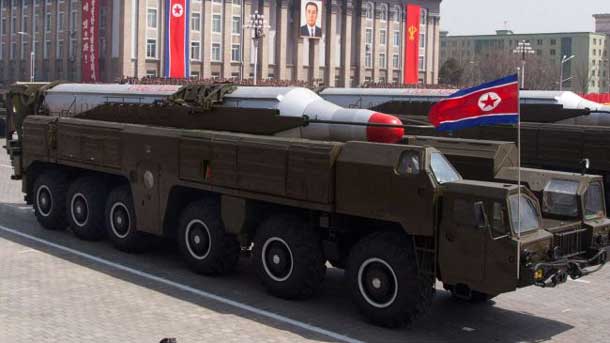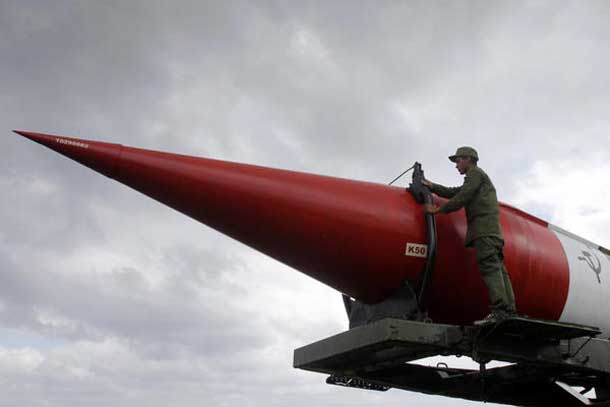Toronto – A nuclear Armageddon was very much on our minds at Harvard in the early 1960s. At the time, I was attending the university as a Frank Knox Fellow. It was a time to think the unthinkable, in lecture halls and even at the movies. The young Henry Kissinger, one of my professors, taught us a popular course in nuclear realpolitik. Based on his book, Nuclear Weapons and Foreign Policy, his lectures assessed the feasibility of a “limited” nuclear war. Future conflicts would have a nuclear dimension, he concluded, so why not wage them on our own terms? (His thesis may soon apply to Iran and North Korea.)
For Kissinger’s course, we read On Thermonuclear War by Herman Kahn (who was soon to open the Hudson Institute), arguing that a nation could “win” such a conflict — if it was prepared to sustain “megadeaths.” In Kahn’s view, Mutually Assured Destruction (MAD) was not inevitable; there could be a winner, of sorts. Compared with the hawkish Kahn, Kissinger was a dove in the world of nuclear politics.
Our favourite movie was On The Beach, based on the Nevil Shute best-seller, starring Gregory Peck, Ava Gardner and Fred Astaire in his only non song-and-dance role. It depicted the last days of our species in a nuclear doomsday. In the fadeout, surely one of the greatest film endings, a sign above a lifeless street in Melbourne proclaims that “There is still time … brother,” to the haunting theme of Waltzing Matilda.
Fifty years ago this month, reality caught up with academic theory and fiction. The 13-day Cuban Missile Crisis confronted us with the very real possibility of a nuclear war. It was only the wisdom and patience of U.S. President John F. Kennedy that served to avoid the “megadeaths.” He rejected the hawkish counsel of his advisors, including brother Bobby Kennedy, to escalate the confrontation beyond his arms blockade — as we now know from White House tape recordings. The crisis ended when Soviet Premier Nikita Khrushchev made a secret deal with JFK to remove his missiles from Cuba if Kennedy removed America’s missiles from Turkey at a later date. In Churchill’s words, jaw, jaw proved to be a better solution than war, war.
“We went eyeball to eyeball with Russia — and they blinked,” was the false boast of an unidentified Kennedy aide. The confrontation, which began Oct. 14 when a U.S. spy plane photographed Soviet missile sites in Cuba, some 80 miles from Florida, ended on Oct. 28. Surely this is a date that deserves to be remembered through the ages. These were JFK’s finest hours.
If Kennedy’s hawkish successor, Lyndon Johnson, who took office just over a year later, had been President in 1962, a more dangerous form of nuclear brinkmanship likely would have taken place. LBJ was soon led into the Vietnam quagmire by the same advisers — Robert McNamara and Dean Rusk, among them — who had insisted on the hard-line military response to the Soviet threat in Cuba.
I remember that period in late October well. Many people did not go to work. In their living rooms, families clustered around black-and-white TV sets for news about whether they might live or perish. One of my best friends simply repaired to bed for the duration of the crisis with the new-found love of his life. I was reminded of T.S. Eliot’s lines: “This is the way the world ends/Not with a bang but a whimper.” My future father-in-law quickly converted his basement into a bomb shelter. People with deep basements or jerry-built nuclear shelters like him were suddenly popular. Some wondered whether it would be morally defensible to shoot a neighbour if he tried to break into their basement shelter. But I felt no huge sense of panic. After all, we were all in this together. And this was a great story, perhaps the last great story.
Adult fear can be infectious to children. My wife remembers being terrified when told by her teacher that nuclear fallout was invisible and odourless. As a 25-year-old Montreal Star reporter, I had watched a class of 10-year-olds in the Town of Mount Royal being taught how to seek cover under their desks. Some kids told me they were watching the sky for Russian bombers or missiles. In a Catholic school, children were told to recite the rosary under their desks. To children, the necessary tests of air raid sirens seemed to be the real thing. I heard of a five-year-old who built a trap of sticks and stones in the garden to catch Castro and Khrushchev.
Some families were advised to pack the car and get out of town — but to where? I figured the safest place would be Washington, because, if the nukes were fired, the capital cities would be spared so there was someone left to negotiate with.
Looking back 50 years later, my most vivid memory is of “the circles” — circles drawn on maps to depict how far north missiles of different sizes could travel from communist Cuba. Montreal seemed to be out of “the circles” — for missiles, that is, but not for radiation, as we all knew from On the Beach.
In 1962, the prescient novel Seven Days in May, co-written by Charles Bailey, one of my mentors when I covered the LBJ White House, told the story of how rogue generals had plotted a coup to seize the presidency during a Cold War crisis. As a movie, it did not do to well at the box office in 1964, possibly because people wanted to forget the missile crisis. But we should always remember what happened 50 years ago — as a sobering reminder of how easily humankind can stumble into apocalypse, if there are not wise leaders to stop at the brink.
Ray Heard
About Ray Heard: As a reporter Ray Heard covered from the White House during the Johnson and Nixon years — Vietnam, the Moon Program, Martin Luther King, and the Struggle for Equal Rights, Watergate. In South Africa, before going to Harvard in 1960 he covered Apartheid at its very worst and first became acquainted with his hero Nelson Mandela whom he later helped to make an honorary citizen of Canada.
Heard served as the Montreal Star’s White House correspondent, and a correspondent for The London Observer and the South African Morning Group, from 1963 until 1973, when he became Editor of the London Observer’s Foreign News Service. In 1976, he returned to the Montreal Star as Managing Editor, with responsibility for all content, and remained with the newspaper until it closed in 1979. Heard then moved to the Global Television Network where he served as Vice President, News and Current affairs, until 1987 when he accepted a position as communications director for Liberal leader John Turner. He is President of Toronto-based Heard-Cosgrove Communications, whose clients include some of Canada’s largest companies. He is a contributor to Canada’s National Post and appears on the CTV, Global and Sun News networks as a political pundit.
This post originally appeared in the National Post.
Printed with permission ©Ray Heard




